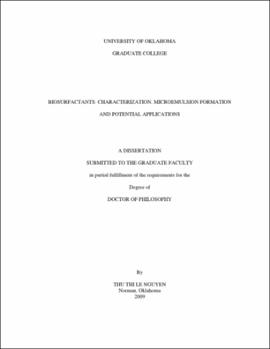| dc.description.abstract | Biosurfactants, which are produced from microorganisms, have become of interest due to their non-toxic nature, their biodegradability and their production from renewable resources. Research has evaluated the use of biosurfactants in a wide variety of potential applications such as environmental bioremediation, biomedical applications, cosmetics, personal care products and perfume and fragrance industry. However, limited research has evaluated microemulsion formulations using biosurfactants. Microemulsions are thermodynamically stable dispersions of oil and water stabilized by surfactant films. Microemulsions possess ultralow interfacial tension and high solubilization capacity, making them desirable in enhanced oil recovery, drug delivery, cosmetic and pharmaceutical applications. Therefore, in this work we characterized the hydrophobicity/hydrophilicity of biosurfactants, specifically rhamnolipid and sophorolipid biosurfactant, and evaluated their ability to formulate alcohol-free microemulsions with a range of oils (both oil types and oil EACNs). We also demonstrated the feasibility of vegetable oil extraction using diesel-based reverse micellar microemulsion; as a result, blends of diesel and vegetable oil were produced and evaluated for biofuel used in diesel engines. Biocompatible lecithin-based microemulsions using rhamnolipid and sophorolipid biosurfactants formulated with limonene and isopropyl myristate were shown to be insensitive to temperature and salinity changes, making them desirable in cosmetic and drug delivery applications. In addition, this work showed that the hexadecane detergency performance of our biocompatible formulation was better than that of commercial detergency and comparable to formulations reported in the literature. | |
